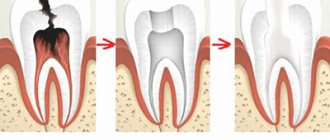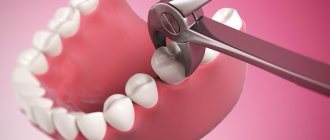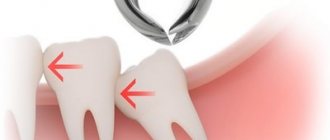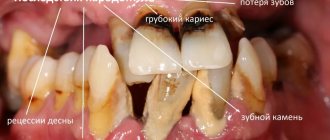At the Line of Smile dental clinic there is no clear policy not to operate on “these days.” But we always try to take into account the cyclical nature of women’s physiology, since surgery during menstruation can negatively affect further wound healing. Therefore, it is important for the client to be honest during the consultation with the doctor and not be embarrassed to ask to reschedule the planned operation. However, if an x-ray shows that there is an infectious focus, removal is carried out on an emergency basis, regardless of what day of the menstrual cycle we are talking about.
Why is it undesirable to have surgery during menstruation?
When planning an extraction, a highly qualified dentist always finds out what stage the woman is in her menstrual cycle. Why is he asking this? It's simple. The quality and composition of the blood directly determines the effectiveness of the anesthesia used and the rate of formation of a blood clot in the socket.
On menstrual days, blood clotting is significantly reduced. That's how it should be. Its composition also changes. Therefore, whenever possible, planned surgical intervention is postponed to “safer” days of the cycle.
Quality standards of the Doctor Levin center
Surgical operations, including multiple tooth extractions, in our Center are carried out in the LifeTime Warranty format, in strict accordance with the Center’s Unified Quality Standards.
An operation to remove all third molars in one day is possible if the following necessary conditions are met in the clinic : 3D computer diagnostics in ENT mode, a full-fledged anesthesiology department, thorough sanitation of the oral cavity, ultrasound surgical equipment, experienced adult surgeons on staff and professional postoperative service.
Dental diagnoses in which periods are not a hindrance
If you doubt whether it is possible to remove a tooth during menstruation, contact your dentist. If the doctor deems it necessary, he will postpone the operation until later.
Indications for emergency intervention are:
- Severe inflammation, a purulent process that can provoke the development of an abscess, phlegmon, infection of the maxillary sinuses, osteomyelitis.
- A retracted (not fully erupted) wisdom tooth that is completely or partially hidden under the gum tissue/bone. It should be removed as soon as possible if a woman suffers from severe pain, swelling and swelling of the cheek.
- A tooth root fracture resulting from an injury.
- An advanced form of periodontal disease, when it is no longer possible to save the unit.
The specialists at the Line of Smile dental clinic never prescribe removal if it is possible to do without it. They always try to save the diseased tooth and prevent its further loosening and loss. If the roots are in good condition, a pin is installed in them, onto which the crown is fixed on top. Surgery is a last resort.
The need for a removal procedure
In some situations, delaying tooth extraction is not advisable and even dangerous. Severe inflammation increases the likelihood of developing sinusitis, otitis, osteomyelitis, sepsis and other dangerous diseases.
Indications for removal on critical days:
- acute pain that is poorly relieved by medication;
- severe swelling, swelling of the cheek;
- purulent inflammation: periodontitis, cyst and other pathologies;
- toothache accompanied by fever;
- acute pulpitis;
- tooth root fracture;
- impacted “figure eight”, which causes severe pain and swelling.
Menstruation does not become an obstacle if a woman is planning a business trip or vacation in the coming days. It is better to solve the problem in advance than to suffer from pain, postponing treatment until you return.
When to delay deletion
Any planned surgical intervention can be postponed for a couple of days until the menstrual bleeding stops.
So, you can wait if you need to delete:
- dystopic tooth located out of place;
- units that impede the implementation of prosthetics and the installation of orthodontic structures;
- wisdom teeth, which constantly injure the gums and mucous membranes of the oral cavity, cause chronic injuries and inflammation.
Chronic diseases often worsen on the eve of menstruation. This is due to a decrease in immune defense. If a woman knows that after menstruation she needs to go to the dentist and have a tooth removed, she should be especially careful about her health so as not to catch a cold. Otherwise, the procedure will have to be postponed indefinitely.
Indications for removal
Medical indications can be divided into 4 main groups.
- Crowding of teeth When even one figure eight erupts in the dentition, crowding occurs in 8 cases out of 10, and promises dire consequences. At contact points, i.e. between teeth, hygiene is compromised, and caries forms. Tooth displacement leads to gum recession and bone loss, especially in the anterior region. Pathology leads to the loss of up to 10 teeth by the age of 40.
- Destruction of wisdom teeth The inaccessibility of the eighth teeth to a toothbrush leads to a natural result - first caries develops, then pulpitis and acute pain. Treatment in advanced cases is not far-sighted, because the probability of relapse is too high, and such a tooth is already useless for future hypothetical prosthetics. Removal is more efficient and cheaper.
- Growing difficulties The eruption of eights is not “prepared” by the pioneer milk teeth. That is why the process of their birth is painful and navigationally unpredictable. Wisdom teeth destroy the roots or crowns of the 7th teeth, grow into the cheek, and compress the trigeminal nerve.
- Orthodontic preparation It is almost always impossible to straighten teeth and form a healthy bite using braces or aligners without removing figure eights - there is not enough space for teeth to move. Orthodontic referral is the most common reason for immediate removal.
How to remove – one at a time or “in bulk”? It is important to understand that from a medical point of view, there is absolutely no reason for the patient to remove wisdom teeth one by one.
Use of anesthetics
All surgical procedures are performed by Smile Line doctors using highly effective modern anesthetics. This guarantees the absence of pain during tooth extraction and makes the procedure as comfortable as possible.
Usually, when working with the first to fifth teeth, infiltration anesthesia is used. The dentist gives an injection, after which a separate area of the oral cavity “goes numb” and becomes insensitive. If it is necessary to pull out the sixth, seventh or eighth molar, the roots of which are very large and deep, they resort to conduction anesthesia.
Recommendations after removal
Regardless of which tooth you removed or just its root, you must follow the rules of the rehabilitation period. Then healing takes place quickly and without complications.
- Do not eat for 2-3 hours after surgery.
- Eliminate hot and solid foods from your diet for 7 days.
- Carefully walk around the socket when brushing your teeth.
- Do not pick out the blood clot and try not to disturb the hole with your tongue until it is completely healed.
- Don't rinse your mouth.
The Vimontal Clinic carries out operations of any complexity using advanced equipment. This allows you to provide assistance with maximum comfort and safety.
Precautions after treatment
If the procedure is performed on menstruation, the dental surgeon tells the patient about possible complications and gives detailed instructions on how to behave to avoid them. To minimize the risk of bleeding, you should stop smoking a few days before surgery. This will have a positive effect on blood clotting. Also the day before, you need to exclude coffee-containing drinks from your diet, reduce the intensity of sports training, and avoid hypothermia and overheating of the body.
Immediately after removal, you need to spend about an hour in the clinic so that the doctor can make sure that a dense clot has formed in the hole. It is not recommended to go to work on the day of the procedure. The best option is to go home and rest.
It is extremely important to follow all medical instructions and take prescribed medications. If your body temperature rises, the wound begins to bleed, your health deteriorates sharply, dizziness and nausea appear, you should immediately seek medical help.
There is no need to rinse unless prescribed by your dentist. You should also not touch the hole with your tongue. This can lead to the clot breaking off and opening the wound, causing re-bleeding. In addition, an uncovered hole is a gateway for infection.
Only a doctor can clearly answer the question of whether it is possible to remove a tooth during menstruation. In our dentistry, experienced surgeons perform tooth extraction. We do everything possible to ensure that our patients become healthy as quickly as possible.
What changes occur in a woman’s body during menstruation?
Is it possible to treat teeth during menstruation?
There is no clear answer to this question. Some dentists recommend rescheduling a visit to the doctor, others suggest focusing on the patient’s well-being. Most often, the session can be postponed, but this does not apply to emergency cases when the person’s future health depends on the operation. Dental treatment on critical days is stressful for the female body. During menstruation, physiological and chemical changes occur in a woman's body, as a result of which her general health deteriorates, her pulse slows down and her blood pressure decreases. Because of this, the patient may experience aggravation of various chronic diseases, for example: diabetes, asthma, gastritis, cystitis, endometritis. If such diseases are present, dentists may refer the patient for consultation to doctors of other specialties.
Dental treatment at the TopSmile clinic
Get an individual consultation with a specialist in our clinic and find out whether it is worth treating your teeth during menstruation
Get acquainted with the service
Common problems that can be caused by wisdom teeth
Most often, problems that arise during the period when eights emerge from the gums are due to the fact that by the time they appear, a person has already formed strong bone tissue, and there is practically no room left for them in the jaw. All this significantly complicates the process of growth and eruption.
A tooth appearing in an already formed jaw can cause the following problems:
- Development of periconaritis. The peculiarity of this pathology is the formation of a “hood”. In addition to the pain that occurs when food gets on the gums and irritates the nerve endings, pathogenic bacteria accumulate in the “hood”, which can cause inflammatory processes in the oral cavity.
- Cyst formation. Dense gum tissue and the space constrained by the formed jaw forces the erupting tooth to grow in the direction of least resistance. Because of this, its roots can grow into the cavity of the maxillary sinus, forming cysts that become infected, inflamed and remain the cause of toothache for a long time.
- Incorrect position in a row (dystopia). As the third molar grows, it can displace teeth that have already erupted. This disrupts the bite and deforms neighboring teeth.
- Caries formation. Eights cause certain difficulties in daily care, as they are located too deep in the oral cavity. Due to poor hygiene, food particles and bacteria accumulate on their surface, creating a favorable environment for the development of infectious processes.
- Damage to the root of an adjacent tooth. During eruption, the third molar puts pressure on the adjacent tooth, thereby damaging its root. This can provoke an inflammatory process or degeneration of dental tissue.
- Incomplete eruption (retention). Impacted third molars can cause quite a lot of problems - they often cause inflammation of the gums and diseases of adjacent teeth.
If the above problems appear, the dentist may recommend resorting to their removal without waiting for the development of more serious complications.
If teeth have not erupted
When wisdom teeth are inside the jaw bone in a “sleeping” state, they can be seen in the picture. Their position is also visible in the picture.
If the teeth are positioned vertically, there is a chance that they will erupt without causing much discomfort or moving neighboring teeth. Then, most likely, they will not interfere with the process of correcting the bite. It often happens that during the treatment process, there is more space in the row of teeth, and wisdom teeth immediately begin to erupt.
Sometimes wisdom teeth are located at an angle or even almost horizontally.
A variant in which wisdom teeth can harm other teeth
In this case, most likely, they will not erupt. And if the growth process does begin, then you can expect, at a minimum, pain and inflammation, since these rather large teeth will put pressure on the surrounding tissues and on the roots of other teeth.
For orthodontic treatment, both options carry a certain risk. In this case, the decision must be made in preparation for treatment - at the diagnostic stage.
- If the eighth teeth do not look problematic, are located vertically, there is no great crowding of other teeth, the teeth are not very large - there is an option to start treatment without removing them, and just observe.
- If the patient’s dentition is severely narrowed, the teeth are naturally large, and the figure eights are positioned incorrectly and can move the roots of adjacent teeth when they erupt—you may have to decide to remove the teeth (or some of them).
In the second case, the doctor needs to foresee not only the course of treatment, but also how the retention stage will proceed. After all, wisdom teeth may begin to erupt even after treatment. Will there be enough space for them, will they move their teeth, thereby destroying the achieved result? This also happens.
List of absolute contraindications
The installation of dental implants is certainly contraindicated in such pathologies as:
- diseases of the blood and lymphatic system;
- malignant tumors, except in cases of remission;
- mental disorders that are accompanied by inappropriate behavior;
- diseases of the central nervous system;
- some autoimmune pathologies;
- a severe degree of bone tissue atrophy, in which it is impossible to increase its volume or use special types of implantation;
- connective tissue diseases;
- drug and chronic alcohol addiction;
- renal failure;
- allergy to all anesthetics used during implantation.
When can I do a simple removal?
1. The rudiment has a root system, like other teeth. 2. Most of the tooth is intact. 3. The third molar is not susceptible to caries damage and tartar. 4. Its location is correct and the doctor can easily reach it.
At the clinic, the patient is seated on a dental chair and the oral cavity is examined. An injection produces pain relief. Small incisions are made, and if necessary, the tooth is ground down. Using a special dental instrument, the specialist pries up the root of the third molar and extracts it. Afterwards disinfection is carried out and the bleeding stops. An anesthetic is placed in the place where the tooth grew and anti-inflammatory drugs are prescribed. The patient can return for a re-examination in a week.
Complex wisdom tooth removal
If we talk about complex operations, the leader is the extraction of an impacted tooth that is not able to erupt on its own. Such manipulation is carried out by a highly qualified dental surgeon.
Anesthesia (local) is prepared for the patient. Then the mucous membrane is cut so that it is convenient to get to the roots. In case of a deep tooth location, the doctor cuts out a flap located above the bones. All this also occurs on the mucous membrane, and the cutout resembles the shape of a triangle. Afterwards, holes are made in the jaw to remove the tooth. For such a procedure you will need a drill or ultrasound equipment. Use forceps to remove the figure eight. In case of large sizes, the tooth is removed in parts. An anesthetic is placed in that cavity, which is now empty. And they stitch up the places where the incisions were. Anti-inflammatory drugs are prescribed and are part of complex therapy.
Surgical intervention is also carried out in a similar way when the wisdom tooth is positioned incorrectly. The most complex manipulations include the removal of a tooth where part of the crown has collapsed. Forceps will no longer help here, so specialists use special instruments (surgical, dental). Initially, a flap located in the gum is cut out, after which the part of the figure eight that has been destroyed is removed. Boron is used for this.
If a tooth is cracked, pieces may come loose. In such situations, they are removed from the gums during the intervention. The next month after such an operation, the patient must visit the doctor according to the schedule. The dynamics of recovery will be observed here. And based on this dynamics, individual treatment is selected that is necessary after the operation.
Methods of dental treatment
No patient can be immune from microtrauma during treatment. The dentist needs to be notified in advance about your state of health, so that in an emergency he understands exactly how to provide first aid.
The most popular procedures performed in dentistry are fillings, x-rays, and prosthetics. All this can almost always be postponed until there are no contraindications.
Sealing
Most dentists are of the opinion that dental fillings during menstruation are possible. The material used for the filling will definitely not be rejected later.
You can have teeth filled during menstruation
If second-degree caries develops and the use of anesthesia is necessary, treatment during menstruation is not recommended. Contraindications include taking antibiotics and using drainage.
Menstruation and prosthetics
Prosthetics is a complex procedure; the doctor and the patient will have to meet more than once. During critical days, you can take an impression, as well as perform all the preparatory steps. Restrictions do not apply to the installation or fitting of prostheses.
However, due to the fact that immunity decreases during menstruation, the foreign body may be rejected. That is why it is better to install an implant, namely screwing a pin into the jaw bone, after the time is favorable for this.
X-ray of a tooth
An X-ray of a tooth can be taken on any day of the menstrual cycle. The procedure is instant, special protection is put on the body, and the beam is directed exclusively to the root site. There will be no harm to the patient's health.
If necessary, x-rays can be taken
Teeth cleaning
Ultrasound used during cleaning does not harm the body. The procedure can be carried out absolutely any day.
Tooth extraction and menstruation
This is a stressful surgery. During this period, the body becomes weakened, and even a minor cut on the gum can lead to infection.
Depending on various situations, the following complications may occur after tooth extraction:
- bleeding lasting more than ten minutes;
- infection, development of inflammatory processes.
If pain occurs, regardless of whether you are menstruating, you should seek help from the hospital.
Why you can’t have teeth removed during your period, when you need to go to the hospital, you can read the answers to these and many other questions just above. But in any case, all advice is only a recommendation, and the final decision can only be made by the attending physician.
What are wisdom teeth?
Dentists and scientists call them a vestigial organ, the need for which disappeared when people learned to heat food. Eights, like all other human teeth, consist of roots, a neck and a crown, but despite this they have certain anatomical features.
Here are the main differences:
- they are only indigenous and do not come in milk;
- their eruption is often accompanied by pain;
- have a larger number of roots - from 2 to 5;
- bent and twisted roots.









